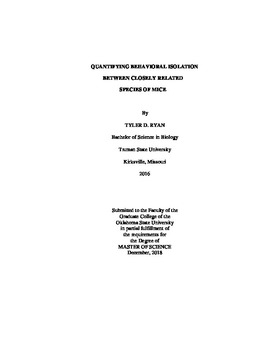| dc.contributor.advisor | Campbell, Polly | |
| dc.contributor.author | Ryan, Tyler D. | |
| dc.date.accessioned | 2019-07-19T14:49:22Z | |
| dc.date.available | 2019-07-19T14:49:22Z | |
| dc.date.issued | 2018-12-01 | |
| dc.identifier.uri | https://hdl.handle.net/11244/320994 | |
| dc.description.abstract | Mate choice, the propensity of one individual to preferentially mate with another individual that expresses certain phenotypic values, can be a strong force in promoting or limiting gene flow between species. Individuals use sensory signals to identify conspecifics and to assess their potential as mates. Signals from heterospecifics may be less attractive or even aversive. Assortative mating in favor of conspecifics, a key component of behavioral isolation, is critical to maintaining species boundaries. However, species boundaries can be permeable between closely related taxa; in sympatry, interspecific overlap in signals used in mate attraction and choice may lead to hybridization. Determining the strength of premating isolation can shed light on the contribution of behavior to the evolution and maintenance of species. Moreover, interspecific gene flow can be affected by mate choice by hybrids, a topic that is generally understudied. Despite evidence for historic gene flow between house mice (Mus musculus domesticus) and Algerian mice (M. spretus), hybrids are not found in nature. However, M. m. domesticus females will mate with M. spretus males in the lab, whereas the reciprocal cross is challenging. This suggests asymmetry in the strength of behavioral isolation. Surprisingly, mate preference is untested in this well-studied species pair. We used a mate choice experiment to quantify the strength of behavioral isolation between M. m. domesticus and M. spretus, and mate preference in their F1 hybrid. Females had free access to a male of each species for 24hrs. M. m. domesticus females spent more time with heterospecific males than M. spretus females, suggesting that the strength of behavioral isolation is indeed asymmetric. Hybrids showed no preference, suggesting that hybrid females may recognize males of both species as potential mates. Combined analysis of mate choice in hybrids and parental species promises novel insight into the behavioral mechanisms that limit gene flow between sympatric congeners. | |
| dc.format | application/pdf | |
| dc.language | en_US | |
| dc.rights | Copyright is held by the author who has granted the Oklahoma State University Library the non-exclusive right to share this material in its institutional repository. Contact Digital Library Services at lib-dls@okstate.edu or 405-744-9161 for the permission policy on the use, reproduction or distribution of this material. | |
| dc.title | Quantifying Behavioral Isolation Between Closely Related Species of Mice | |
| dc.contributor.committeeMember | Luttbeg, Barney | |
| dc.contributor.committeeMember | Moen, Daniel S. | |
| osu.filename | Ryan_okstate_0664M_16055.pdf | |
| osu.accesstype | Open Access | |
| dc.description.department | Integrative Biology | |
| dc.type.genre | Thesis | |
| dc.type.material | Text | |
